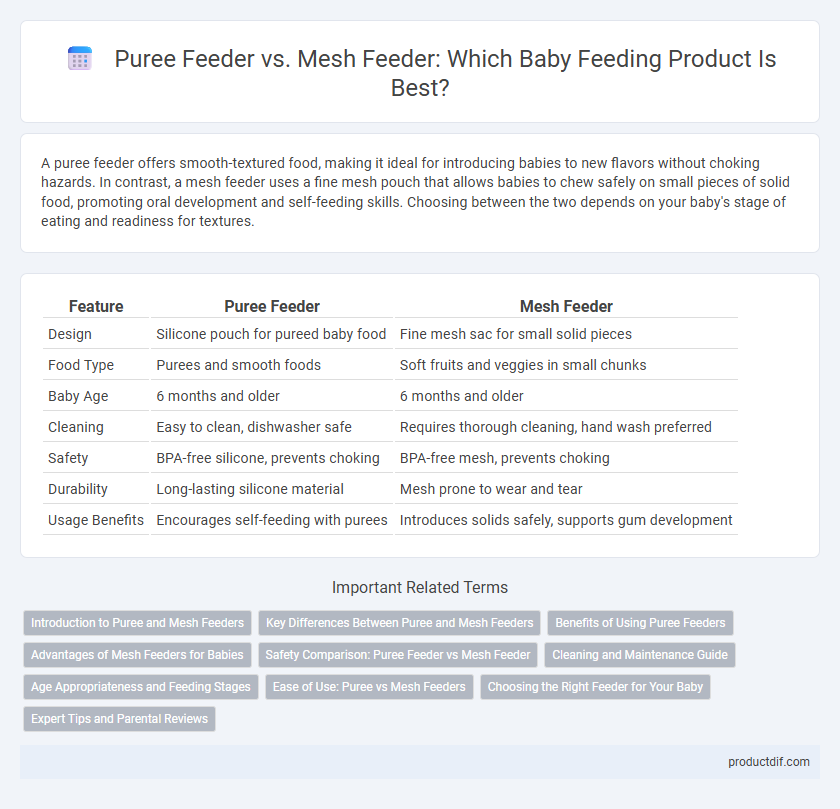A puree feeder offers smooth-textured food, making it ideal for introducing babies to new flavors without choking hazards. In contrast, a mesh feeder uses a fine mesh pouch that allows babies to chew safely on small pieces of solid food, promoting oral development and self-feeding skills. Choosing between the two depends on your baby's stage of eating and readiness for textures.
Table of Comparison
| Feature | Puree Feeder | Mesh Feeder |
|---|---|---|
| Design | Silicone pouch for pureed baby food | Fine mesh sac for small solid pieces |
| Food Type | Purees and smooth foods | Soft fruits and veggies in small chunks |
| Baby Age | 6 months and older | 6 months and older |
| Cleaning | Easy to clean, dishwasher safe | Requires thorough cleaning, hand wash preferred |
| Safety | BPA-free silicone, prevents choking | BPA-free mesh, prevents choking |
| Durability | Long-lasting silicone material | Mesh prone to wear and tear |
| Usage Benefits | Encourages self-feeding with purees | Introduces solids safely, supports gum development |
Introduction to Puree and Mesh Feeders
Puree feeders are designed with soft silicone tips that allow babies to safely taste smooth or mashed fruits, vegetables, and other soft foods, promoting early self-feeding skills. Mesh feeders consist of a fine mesh pouch that holds small pieces of solid foods, enabling babies to explore textures while reducing choking hazards. Both feeders support the transition from milk to solid foods, encouraging sensory development and independent eating.
Key Differences Between Puree and Mesh Feeders
Puree feeders use soft silicone or BPA-free plastic containers to hold blended fruits and vegetables, allowing babies to explore smooth textures while reducing choking hazards. Mesh feeders feature fine nylon or silicone mesh pouches that hold small pieces of solid food, promoting self-feeding and gum stimulation more effectively. Puree feeders are ideal for introducing single-ingredient purees, whereas mesh feeders support textural variety and gradual transition to solid foods.
Benefits of Using Puree Feeders
Puree feeders offer precise portion control and reduce the risk of choking by delivering smooth, easily digestible food to babies. Their design promotes self-feeding skills and encourages the transition to solid foods while maintaining a hygienic feeding experience. Compared to mesh feeders, puree feeders ensure consistent texture and are easier to clean, enhancing convenience for parents.
Advantages of Mesh Feeders for Babies
Mesh feeders offer enhanced safety by reducing choking hazards through finely woven material that allows babies to chew on fresh fruits and vegetables without swallowing large pieces. They promote sensory development and self-feeding skills by encouraging babies to explore different textures and flavors while strengthening their gums. Mesh feeders are easy to clean and reusable, making them a hygienic and cost-effective choice for introducing solid foods to infants.
Safety Comparison: Puree Feeder vs Mesh Feeder
Puree feeders offer a secure way to introduce smooth textures without choking hazards by containing pureed food in a soft, sealed pouch, while mesh feeders use fine mesh bags that allow babies to chew on small pieces safely, reducing the risk of large food chunks causing obstruction. Mesh feeders require careful cleaning to prevent mold buildup, which can pose health risks, whereas puree feeders are generally easier to sanitize with minimal crevices. Both designs aim to promote self-feeding and exploration but differ in material composition and maintenance needs that impact their overall safety profiles for infants.
Cleaning and Maintenance Guide
Puree feeders require thorough disassembly and cleaning of silicone sacs to prevent residue buildup, typically using warm soapy water or a dishwasher-safe cycle. Mesh feeders demand frequent mesh replacements and careful rinsing after each use to avoid bacterial growth and clogged holes. Both feeders benefit from regular sterilization to maintain hygiene and ensure safe feeding practices for infants.
Age Appropriateness and Feeding Stages
Puree feeders are ideal for infants around 4-6 months old who are beginning to explore solid foods, providing a smooth, controlled introduction to pureed textures. Mesh feeders suit babies aged 6 months and older, perfect for self-feeding with slightly chunkier or grated fruits and vegetables, promoting chewing skills. Both feeders support safe transition through feeding stages, catering to developmental needs and reducing choking risks.
Ease of Use: Puree vs Mesh Feeders
Puree feeders offer a straightforward feeding experience by allowing soft, blended foods to be easily dispensed, reducing mess and simplifying cleanup. Mesh feeders require filling with small pieces of fruits or vegetables, which can be more time-consuming but provide babies the opportunity to self-feed safely while exploring textures. Parents often find puree feeders more convenient for quick meals, while mesh feeders encourage fine motor skills despite the slightly more complex setup.
Choosing the Right Feeder for Your Baby
Choosing the right feeder for your baby depends on their developmental stage and safety needs, with puree feeders offering smooth, blended textures ideal for younger infants and mesh feeders providing a safer option for introducing soft solids while minimizing choking risks. Puree feeders typically consist of a silicone nipple that releases pureed foods gradually, promoting oral motor skills, whereas mesh feeders feature a fine net that allows babies to gnaw on small pieces of fruit or vegetables, encouraging self-feeding and texture exploration. Evaluating your baby's readiness for solids, texture preferences, and ensuring easy cleaning can guide in selecting between puree and mesh feeders for a safe and enjoyable feeding experience.
Expert Tips and Parental Reviews
Experts recommend pureed feeders for introducing smooth textures, emphasizing ease of digestion and allergy prevention, while mesh feeders are praised by parents for encouraging self-feeding and reducing choking risks with soft finger foods. Parental reviews highlight puree feeders' convenience during early stages, whereas mesh feeders receive positive feedback for promoting independence and sensory development. Choosing between the two depends on the baby's developmental stage and feeding goals, with many parents combining both feeders for a balanced approach.
Puree Feeder vs Mesh Feeder Infographic

 productdif.com
productdif.com